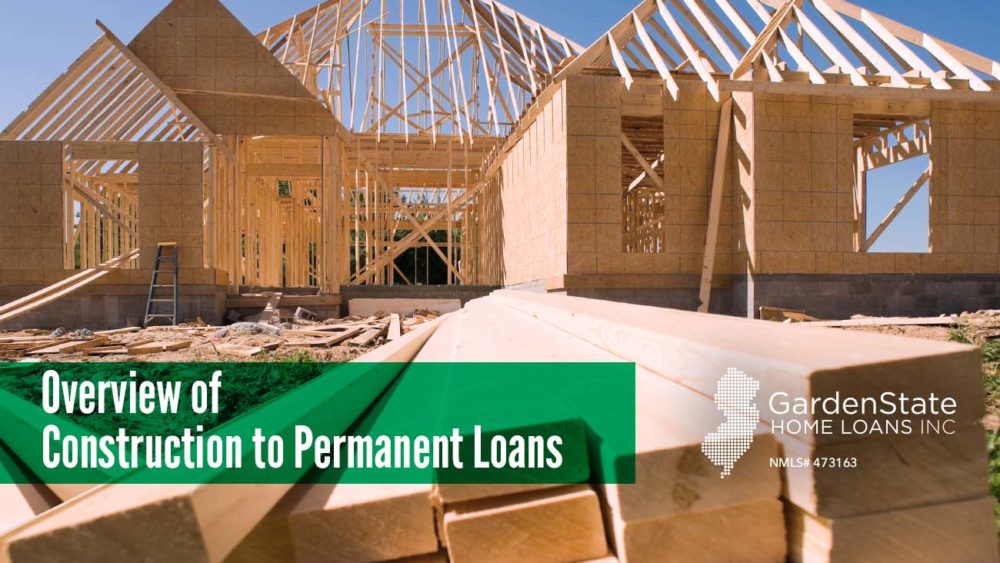Construction to Perm Loans: An Overview

If you’re having a home built for you, it’s important to understand how to obtain the proper financing. More than likely, it will be worth your while to look into a construction to permanent loan. A construction to permanent (CP) loan is essentially two loans in one: it allows you to combine financing for the construction of your new property— or for major renovations on an existing one— with your permanent mortgage.
With a CP loan, payments will be made by the lender to cover the costs of the construction or renovations. During this time, the borrower will pay interest only on the outstanding balance of the loan. Once construction is finished, the loan will be converted into a permanent mortgage. On the surface, the structure of a CP loan seems fairly simple, but there are a number of steps along the way before the construction loan is converted into a permanent mortgage.
Application Phase
For many borrowers, the application phase will be the most overwhelming stage of the CP loan process. There are a number of steps to complete before construction can begin, which often makes this phase the most hectic. A lender will want you to have a builder already selected, as well as an appraiser to review your property, plans, specifications, and comparable homes in the area to determine the value of your home. Following this, the lender will work with you to create a disbursement schedule to determine how and when construction payments will be made. After a schedule has been finalized, and assuming the builder has received the lender’s approval and signed a construction loan agreement, the lender will contact your closing agent to ensure clear title to your property. Assuming all has gone well to this point, the lender will prepare the final approval and the loan will be ready to close. It’s important to note that it is during this phase that the interest rate for your loan is set. The rate will lock at closing, so even if rates improve (or worsen) during construction, you will still pay this rate on your permanent mortgage.
Building Phase
This period consists of the actual building process of your home that is associated with your loan. Once you have been approved, you will then start to receive the payments from the loans. Here the contractor working on your home will provide multiple invoices to the lender throughout the entire construction process. The lender will then provide the contractor with the funds for both their labor and the projects completed. It is essential to make sure both you and your lender are regularly checking up and inspecting the work area of your home to make sure that the contractor is completing the work accurately and within the guidelines of your loan.
Conversion Phase
The conversion phase is the final stage of the process, in which your loan is converted into a permanent mortgage. Like any other mortgage, you can choose from a variety of loan options, such as fixed-rate or adjustable, a 15 year or 30 year mortgage, etc (But remember: the interest rate on the mortgage was set at the initial closing). At conversion, the borrower will have a handful of fees to pay. These include the initial escrow of homeowner’s insurance and taxes, prepaid interest for the permanent mortgage, any unpaid interest due from the building phase, and additional title fees if necessary. Following conversion, the CP loan process is complete and you will begin regular monthly mortgage payments.
A CP loan has many advantages over the alternative— a stand alone construction loan. It is important, however, to evaluate all of your options before determining which type of loan is best for you. Below is a quick list of the pros and cons associated with a CP loan.
Pros of a Construction to Perm Loan
CP loans can provide you with many great opportunities and advantages. For example, even though this loan is essentially two loans in one, you only have to close on it once. This does not only save you a great deal of time, but also saves you money. It also is a lot less stressful and complex to only deal with one loan. In addition, you can take advantage of being able to lock in your interest rate with a construction to permanent loan. For example, if you lock in with a low interest rate and during your construction process the interest rate increases, you do not have to worry because you are locked in. Also, should anything happen during the period of construction, such as a drastic drop in income, you don’t have to worry about re-applying for a mortgage.
Cons of a Construction to Perm Loan
Although CP loans are often more affordable than stand-alone construction loans, as a result of saving on closing costs, this is not always the case. CP loans often require a downpayment of at least 20%, whereas stand-alone loans do not. If you do not feel comfortable making a downpayment of at least 20%, you may consider a stand-alone loan the superior option.
The early rate lock on a CP loan, while sometimes a blessing, can also be a curse. If interest rates drop during the time of construction, you will still have to pay interest at the higher initial rate.


Comments are closed.